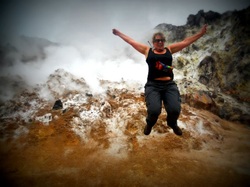
1. Vomit Comet Avoidance -Getting up at 5.30am means we can catch the early ferry off Roatan when the sea is much calmer.
2. Volcano Boarding -Staying in Leon, rather than Comayagua, besides being in a quaint colonial city, means we will be able to tackle two additional activities... one is ‘surfing’ down an active volcano and the other is..
3. Live Lava
Everyone has agreed to a USD30 charge to bypass the usual overnight stop and head for Leon which is not on the normal itinerary. As compensation we will be able to stay in better accommodation than anticipated and because we will be using private transport the journey should be quicker. For me, the main attraction in Leon is that it is the only place in the world where you can 'surf' an active volcano and it is the only place on this trip that we will have the possibility of seeing molten magma or 'live' lava.
The GAP group have also opted for private transportation, to take them directly to Grenada to give them an extra night in the city. Grenada is a further 2 hours from Leon and we do not fancy 21hours in a bus just for an extra night in the city. Besides they will miss the volcano boarding and the lava!
But ours turns out to be also a long, long drive day and it’s 10.30pm when we wake the guards at the border crossing into Nicaragua and 01.30am when we eventually arrive at our hostel. Definitely not an upgrade but we’re too tired to complain. Anyway, for those of us volcano boarding , we only have 4 more hours before we have to be up again. Maybe it wasn’t such a good idea after all.

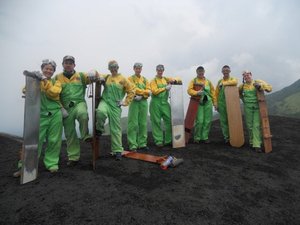
Miguel gives us the bad news. We will have to carry our own boards and protective clothing and climb the volcano surface to the top. As we set off the rain starts to fall and before long we’re a pretty soggy party staggering up the barely visible path, around and over boulders and up the slippery slope. As we climb around and up the volcano, the rain and mist start to lift and we get a greater appreciation of the volcano (which is dark and lava gravel coated) and the surrounding countryside which evidences older volcanoes covered in lush, green vegetation. Eventually we reach the lower rim of the volcano crater and can see down into the crater itself. No lava visible here but lots of red and white boulders with white steam, or is it smoke, billowing out of many points where the crust is particularly thin. It’s like a different planet. Cerro Negro last erupted in 1999 but is closely monitored with experts predicting another large eruption very soon. We’re not daunted and a few of us manage to persuade Miguel to take us down a path into the crater. It’s not recommended, due the instability of the crater surface and the very real risk of death, so the others decide to remain on the relative safety of the rim. Down in the crater, we can feel the heat, and by the steam vents it is unbearable. There are a couple of large boulders so we decide to take some ‘jump’ photos from the boulders. As we land, we can hear a hollow echo beneath us. Time to make a quick exit! We scurry back the crater rim and start the climb to the far side where the rim is much higher.
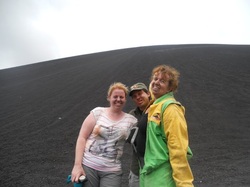
We head off back down the lane, past the village where a baseball match has just kicked off. The modern baseball team kit they are wearing seems incongruous with the traditional clothing and antiquated lifestyle we witnessed earlier but baseball is a huge sport here in Nicaragua.

Then it’s back in the jeeps for the 30km drive to the volcano. Once off the main road we drive up a narrow lane which gradually gets worse as we go. Our driver shifts into 4WD and we are thrown from side to side across the vehicle as he negotiates the deep ruts left by the heavy rains and climbs the hill leading to the base of the volcano.. At times it feels like the jeep will tip over on its side but eventually we reach a clearing in the woods and the jeeps come to a halt. Our hike starts here. Making sure I have water and my head torch, I regret not finding time to purchase a few snacks as it will be a long evening. The hike starts with a gentle climb up the original lane through the lowland woods, until we exit the woods and have stunning views of the surrounding volcanoscape. Many of the other slopes are covered in lush vegetation, but the lower slopes of Telica remind me of the hills I hike at home in Snowdonia, rocky outcrops, low bushes and short grass, but with a few more lava bombs or boulders. To our right it’s hard to tell whether the cloud from the crater is rain or gas but as it comes closer, the sulphur hits the back of our throats. Miguel guides us further round the slope to avoid it and I realise that, in the rush, I have also forgotten my scarf to protect me from inhaling the sulphur. As we climb the slope, the grass disappears and we are clambering up the rocks to the first ridge, where we stop for a brief rest to drink and snack and to assess the viability of accessing the crater with the possible rain cloud on one side the crater gases on the other. With a high blanket of cloud there is no possibility of any sunset either but we can feel the chill in the air as twilight approaches. The goats nibbling at grass tufts in an old crater nearby ignore us as we ponder the options. But as dusk falls, the rain cloud dissipates and the gas cloud seems to disappear as well. We continue to climb to the rim of the main crater. It’s difficult to explain the feeling as we reach the rim. There’s no ‘Elf & Safety’ here. No steps to the top. No protective hand rail. No gas masks nor hard hats. Just nature and us, balanced precariously on the edge of a 120m vertical drop into molten rock at 1200C. In fact, the rock we are standing on juts out so we are not even on a solid cliff edge. As the sky darkens the magma glows more brightly and, as it swells up and recedes far below us, in the stillness of the night, it sounds like the ocean waves on the beach. Above us, the thunder crashes and lightning cracks the night sky but instead of the downpour we’re expecting the sky clears to reveal the twinkling stars. We could spend all night here staring into the bubbling magma but supplies of water are completely depleted and we still need a couple of hours to descend.
No moon to guide us as we make our descent over rocks and rubble, stumbling and slipping as they wobble beneath unsteady feet. Even our guide, Miguel, occasionally loses his footing and with no visible path down I stick close behind him, shadowing his footsteps with my own. It seems to take forever before we reach the main track back to the vehicles and as I head the line back through the forest, I see eyes everywhere in my torch light, and fireflies occasionally dancing off before me .The soft dampness of thread glistening with evening dew tickling my face as I break through the spider webs in the path. Once in the jeeps, we have to negotiate the deep ruts of the track descent in pitch dark. It’s even more hazardous and several times we are left wondering if our friends behind have come to grief as the headlights of their jeep behind us disappear for several minutes. Back in town we only have a few minutes to claim our rucksacks and jump on the bus to our next stop.. the oldest city in the New World, Granada


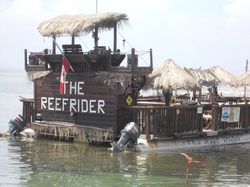

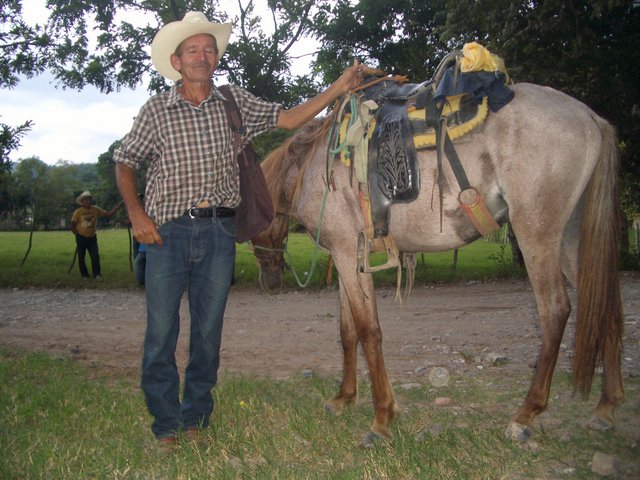

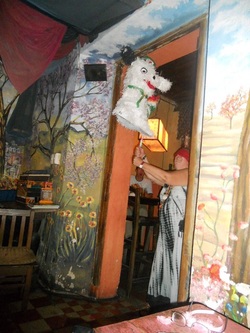
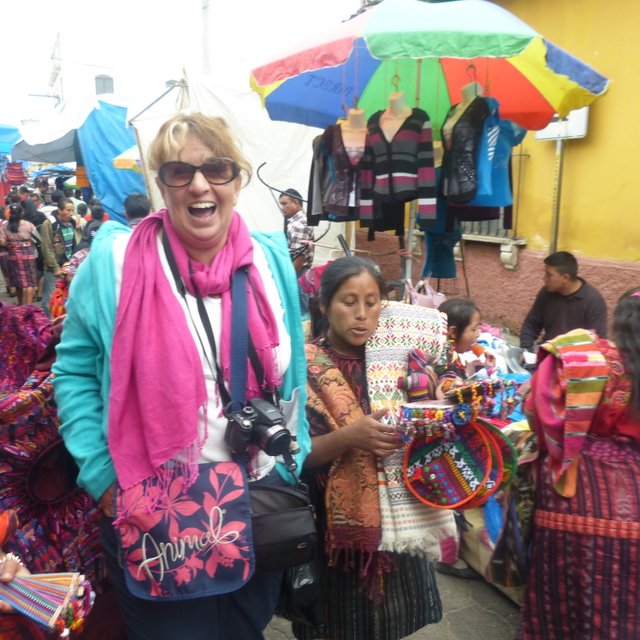
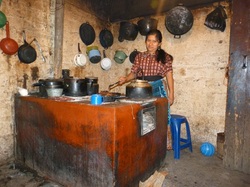
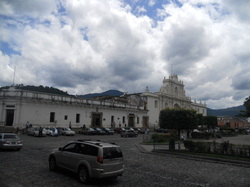
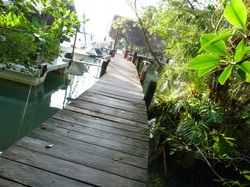
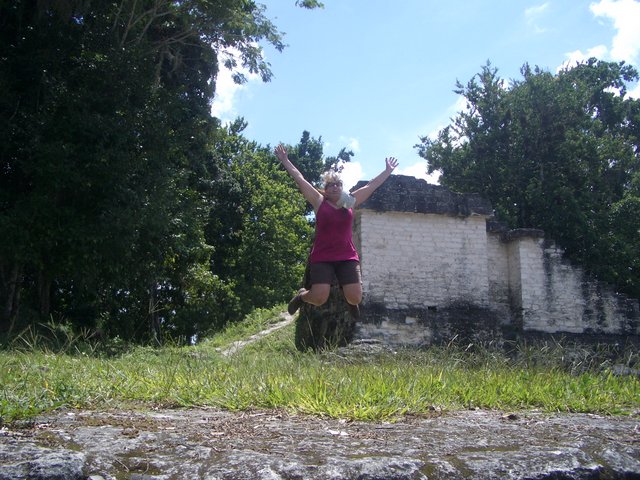
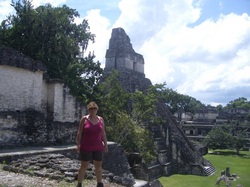


 RSS Feed
RSS Feed
